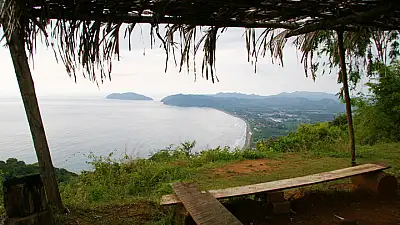
6 Cool Facts about Manuel Antonio National Park
Manuel Antonio National Park is one of the most popular travel destinations in Costa Rica and for a good reason. This protected area boasts an incredible biodiversity that includes unique wildlife, pristine beaches, and lush rainforests. Every year, thousands of visitors flock to Manuel Antonio National Park to experience all that it has to offer. But there's more to this park than just the stunning views. In this blog post, we'll share with you six cool facts that you might not know. Get ready to discover interesting information about this beautiful natural wonder!
1. Small, but Spectacular! 😎📸🌺

Manuel Antonio National Park may be the smallest national park in Costa Rica, but it certainly boasts the most fame and recognition. Set on the country's Pacific coast, the park spans just over 4,000 acres but is home to a diverse range of flora and fauna, including white-faced monkeys, sloths, coatis and toucans. Its compact size also means that visitors can easily explore a large portion of the park in one day, making it a popular tourist destination. Despite its smaller size, Manuel Antonio is the most beloved and visited national park in Costa Rica, attracting travelers from around the world who come to explore its natural beauty and experience the country's renowned biodiversity.
2. Biodiversity 🌳🦥🐢

And speaking of biodiversity, Manuel Antonio National Park is home to an abundance of fascinating flora and fauna, making it one of the best places in Costa Rica for nature lovers to visit. The park is home to over 350 different bird species, making it a fantastic place for birdwatching enthusiasts. Additionally, visitors can catch a glimpse of some of the park's 109 mammal species. It is possible to spot all four species of Costa Rican monkeys inside Manuel Antonio National Park. The squirrel monkey, white-faced capuchin monkey, mantled howler monkey, and the Central American spider monkey all call the park home. The park is also home to over 100 species of reptiles and amphibians, including iguanas, geckos, and snakes, as well as over 350 different plant species which include tropical hardwoods, palm trees, and many flowering species. The park is also a major nesting site for Olive Ridley, a species of green sea turtle, which come ashore to lay their eggs along the park's beaches each year.
3. Such Rare Beauty 🐒🦉🐾🐸

Manuel Antonio National Park is renowned for its incredible biodiversity, which includes a variety of rare and exotic animal species. Visitors to the park can witness numerous animals in the wild, some of which are rarely seen anywhere else in the world. Among the rare animals found in Manuel Antonio are the grey-crowned squirrel monkey and king vultures, which are difficult to spot in the wild. The park is also home to several species of sloths, including the brown-throated and the Hoffman's two-toed sloth. Visitors may also have the opportunity to see toucans, snakes, iguanas, coatimundis, red-eyed tree frogs, and an array of colorful butterflies and birds. With all these animals, Manuel Antonio National Park offers a unique and unforgettable experience for travelers who want to explore Costa Rica's rich wildlife diversity.
4. A Local Effort 🏆🏞️💚

Manuel Antonio National Park is situated in the Central Pacific Conservation Area of Costa Rica. The origins of the park itself can be traced back to the 1960s when local business people and conservationists recognized the need to protect the area's stunning natural beauty and the location's rich history. The process began with a simple petition to the government to protect the area. Thanks to their efforts, the land was declared a national park in 1972, with an area of 682 hectares. In 1983, the park was expanded to encompass 1,983 hectares, and today it is one of Costa Rica's most popular national parks, attracting over 150,000 visitors each year. The declaration of the land as a reserve involved a lot of community action, as well as government backing for the establishment of a park. Locals and visitors alike are free to enjoy this area’s unspoiled beauty directly as a result of this successful grassroots effort, and the continuing conservation efforts that are still underway.
5. Interesting Geography 🗺️🥾🍃

Manuel Antonio National Park is home to a diverse range of ecosystems and geographical features. The park consists of dense tropical rainforests, pristine beaches, and coral reefs. There are also several small islands and islets just off the coast. The park has a number of hiking trails that offer breathtaking views of the ocean while you’re surrounded by dense green vegetation. With this unique blend of tropical rainforest and coastal geography, it’s no wonder Manuel Antonio is Costa Rica's most popular park.
6. Cathedral Point ✨🏝️🌟

Cathedral Point is one of the most iconic and recognizable landmarks within Manuel Antonio National Park. It is a rocky outcropping that juts out into the ocean, providing visitors with stunning panoramic views of the park's beaches and lush jungle. Cathedral Point was formed by the action of the Pacific ocean over many years. The outcropping is made up of sedimentary rock that was deposited on the ocean floor millions of years ago. As tectonic plates shifted and the ocean level changed, the rock was pushed upward and eventually exposed to the elements. Over time, waves eroded the rock, carving out the unique shape of Cathedral Point we see today.
Manuel Antonio National Park is a true national treasure. Its stunning coastline, verdant rainforests, and diverse fauna and flora make it a must-see destination for any nature lover. The park's commitment to conservation and sustainability ensures that its pristine natural beauty will be preserved for generations to come. Whether it's the sight of a sloth lazily hanging from a tree or the sound of waves lapping against the shore, Manuel Antonio promises visitors a once-in-a-lifetime experience.
 Browse All
Browse All
